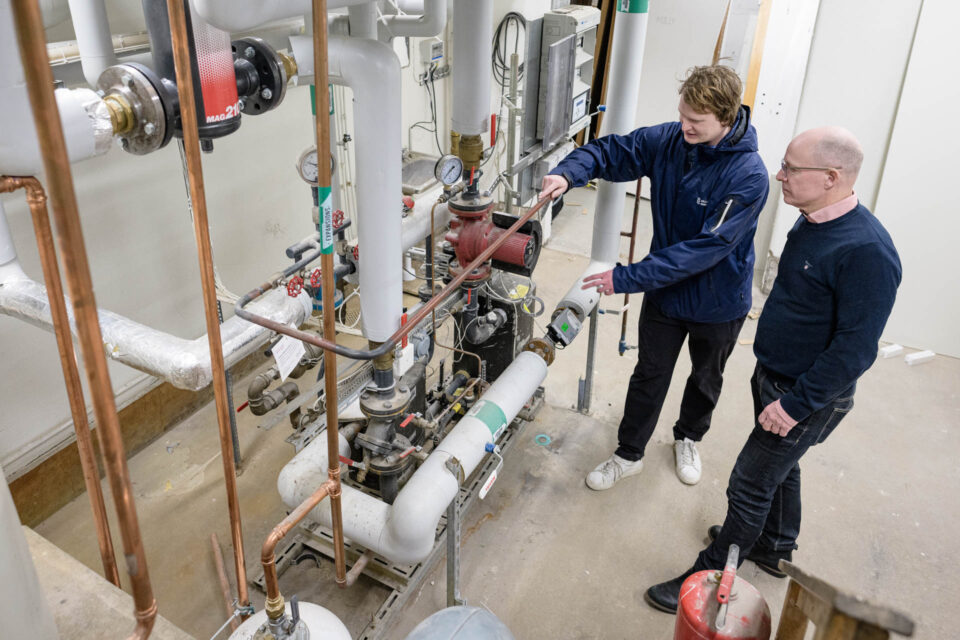Change is in the air in Stockholm, Sweden’s capital city. Energy company Stockholm Exergi is making the supply of heat to a total of 800,000 people and production of electricity to the power market more sustainable and efficient. The company is pursuing an ambitious goal – namely, to be climate-neutral by 2032.
Driven by this vision, Stockholm Exergi is relying almost entirely on renewable or recycled energy and on modernizing the city with innovative technologies. “This includes setting up battery parks to store more energy from sustainable sources and retrofitting buildings to better distribute and use electricity and heat,” says Nils Berge, energy systems engineer at Stockholm Exergi. However, climate neutrality will not be the only benefit for the metropolitan region, as Erik Brisenheim, Technical Director at ebm-papst Sweden, explains: “For Stockholm, a more efficient energy supply also means more independence, especially in the winter months when many households need heating at the same time. Until now, the Swedish capital has been dependent on additional energy from abroad.”
Advantages of the ventilation system in residential buildings
- Demand-based ventilation
- Improved air quality
- Remote monitoring and control
- Reduced energy usage
Better use of energy thanks to retrofit
In addition to new district heating connections, Stockholm Exergi is relying primarily on modern ventilation and air-conditioning systems for its building retrofits. These systems are particularly needed on cold Scandinavian days. This is because ventilating with open windows would cool down interiors too much and require more energy to heat them up again. Swedish buildings therefore nowadays use ventilation systems with heat exchangers, which heat the fresh air before it reaches the interior. However, buildings built in the 1970s and earlier only have an exhaust fan without heat recovery. “In addition, many systems still use old AC roof fans that are difficult or impossible to control, so they run at full power or not at all. There is often nothing in between to cover the actual demand for fresh air. And that costs the operators and residents unnecessary energy and money,” adds Nils Berge.
Better living
The Intelligate Air X gateway controller uses sensors to monitor the indoor air quality and controls the EC rooftop fan as required.
In an older residential building in the Östermalm district, however, Stockholm Exergi shows how “efficient ventilation” can set a precedent. For the retrofit project at Gyllenstiernsgatan, the company is relying on a complete solution from ebm-papst with the MXRC III EC rooftop fan and the new Intelligate Air X gateway controller from ebm-papst neo, including sensors and cloud connection. The rooftop fan is not only impressive due to its energy-efficient performance. “It is also very quiet and vibrates very little so as not to disturb the residents,” adds Erik Brisenheim.

The gateway controller can send data without having to interact with the customer’s network.
Erik Brisenheim, Technical Director at ebm-papst Sweden
The gateway controller also connects the fan to various external sensors and to the cloud. Thanks to the integrated Narrow Band IoT modem, the Intelligate Air X can communicate with the cloud and transmit sensor data independently of the local network. “This also means that the gateway controller can send data without having to interact with the customer’s network,” says Erik Brisenheim. “The data transmitted allows the ventilation system to be monitored remotely and controlled continuously and automatically. This makes it easy to provide ventilation exactly when it is actually needed, thereby saving a lot of energy.”
Full control from anywhere
The ventilation system can also be monitored and controlled remotely via cloud. The data stream runs independently of local internet access via an NB-IoT modem.
Improving life, one project at a time
The retrofit is a win-win situation for all parties. Thanks to the availability of measurement data and analyses via the cloud, owners have a perfect overview of how often the building is ventilated and how much energy this consumes. “For residents, the main benefit of the new ventilation system is greater living comfort because it improves the indoor air quality. This is because the sensors and gateway controller measure several parameters in the exhaust air and controls the flow for the ventilation as required,” says Erik Brisenheim. “The system can also detect what the weather is like outside and adjust the ventilation accordingly. As a result, residents also save overall utility costs, as the system is not constantly running and consuming electricity.”
So the retrofit in Gyllenstiernsgatan will not be the last. On the contrary: together with ebm-papst, Stockholm Exergi is already planning more retrofit projects in Stockholm, mainly in buildings belonging to Swedish housing cooperatives, or “Bostadsrättsförening” (BRF). The residential building in Gyllenstiernsgatan was therefore just the beginning and a blueprint for Stockholm Exergi to modernize other buildings and make them more energy-efficient – all with the main aim of reducing Stockholm’s emissions.







Leave a comment